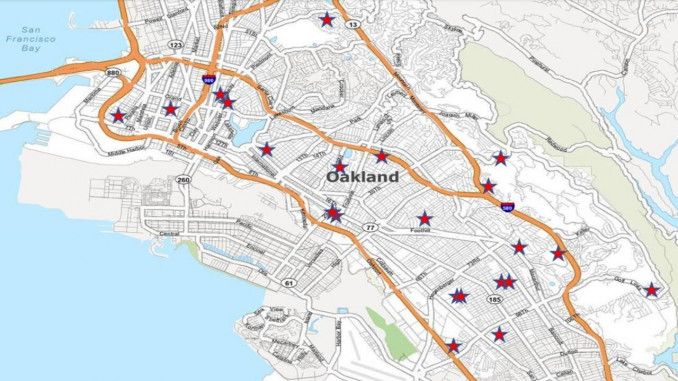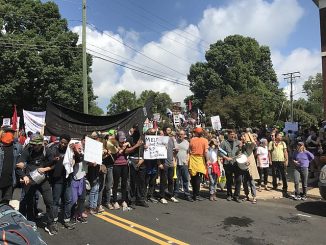
Schools are anchors for a community, bringing together whole families, students, teachers, and staff. Because of this, when they are closed, it is a huge disruption in the students’ educational experience as well as in people’s lives throughout the community, disconnecting a fabric of social ties.
Recently, the plan to shut down up to 16 schools within two years by the Oakland Unified School District (OUSD) has been made public. They are proposing to shut down 12 schools at the end of this school year and to merge two schools into one. They are also floating the idea of shutting down four more schools and merging another four schools into two at the end of the next school year. The schools in question are overwhelmingly in working-class neighborhoods that serve Black and Brown students.
The argument that is being used to close schools is that OUSD is facing a long-term structural deficit and this is largely blamed on having “too many schools – particularly too many small schools.” The argument that school closures save money is not supported by the district’s own data, nor in the analysis done by other school districts around the country. In addition, there is plenty of research to show that closing schools has a neutral or negative impact on the academic performance of students after they go through the experience of closure.
On Oct. 27, the Oakland School Board voted to make $6 million in budget cuts in lieu of closing more schools. Very soon afterward, on Nov. 8, the Alameda County Superintendent, Karen Monroe, threatened to take over OUSD, citing a concern about the budgets for upcoming school years based on imagined financial projections. The County is now demanding that OUSD cut $90 million (out of a $670 million total annual budget) by the end of January or else its finances will be taken over by the Fiscal Crisis Management and Assistance Team (FCMAT), a non-governmental agency that is unaccountable to voters and the Oakland school board directors, and superintendents will have their salaries suspended. The school board then unanimously voted on Nov. 13 to appeal the Alameda County Superintendent’s letter to State Superintendent of Public Instruction, Tony Thurmond.
While OUSD does have financial problems, FCMAT is a big part of the reason. This is not the first time that OUSD has been taken over by FCMAT. The last time was a disaster for the Oakland community.
In 2001, OUSD had a $37 million budget shortfall and the district was forced into a state takeover (or so-called “receivership”). The district was then forced to accept a $100 million loan – way more than it needed – which would necessitate interest payments for many years. This was largely orchestrated by then-Mayor of Oakland and former Governor of California, Jerry Brown. From 2003 to 2009, OUSD was under total state control: the school board held no power, while state-appointed administrator Randolph Ward was made the de facto dictator of the district. Oakland became a privatization laboratory in the hands of education-privatization magnate Eli Broad, whose organization The Broad Academy trains pro-corporate administrators such as Ward. Broad’s Academy is responsible for orchestrating school closures and school privatization all over the country. The school board was stripped of all power, and the state made the district a laboratory for all sorts of privatizing schemes pushed by wealthy figures like Eli Broad. One of the projects pushed during this time with some support from the community was the “small school movement” whereby larger schools were broken up into smaller ones. In addition, during the state takeover, there were layoffs and pay cuts to staff across the district. Programs such as libraries were shut down and many services were sold off to private companies. By the end of the takeover, the enrollment in Oakland public schools had declined by roughly 38,000, with many of the students moving to charter schools. Enrollment in charters increased fourfold. Charter schools are estimated to drain the district of $57 million annually.
While the state takeover was supposed to get the OUSD finances in order, it ended up tripling the deficit to $110 million by the time they left in 2009! OUSD still continues to pay around $6 million annually to service the original loan that was forced on it by the FCMAT. Despite making enormous cuts throughout the district, the growth of private contractors and district administrators exploded. By 2009, OUSD had double the expenditures for contractors and administration of comparable districts in California. These costs continue to be an enormous burden on the budget today.
School closures continued following the state takeover. Since 2004, 21 schools have been closed. The most recent have been Roots International Academy and Kaiser Elementary, despite hard fights to keep them open.
Why are they pushing an agenda to close schools so aggressively when it is clear that it neither saves on costs nor improves student performance?
Major factors are the power of the charter school industry and that of real estate developers. Of the 21 schools that have been shut down since 2004, 11 of the former campuses have since been taken over by charter schools. The school privatization industry has a powerful lobbying machine, as it has big money behind it: the charter industry, real estate companies, private vendors of education services (food, libraries, etc.) and billionaire “philanthropists” like Eli Broad and Michael Bloomberg, who think that corporate takeover is the solution to everything. Is it a surprise that current School Board President, Gary Yee, has been reported to have received $120,000 for his most recent election campaign from billionaire charter promoter, Michael Bloomberg?
In other parts of the country, the needs of the real estate industry are at play as well. For example in Philadelphia, 21 of the 26 schools that were shut down and sold between 2013-2015 went to developers seeing prime locations for commercial or residential use.
Lastly, regardless of OUSD finances or the threats of a takeover from the Alameda County Superintendent, why is there talk about shutting down schools or budget reductions when there is an abundance of wealth in the region and society in general? The State of California, controlled by Democrats, is reported to sit on a budget surplus of $31 billion. If this is not enough to adequately fund education in the state, then let’s find the money elsewhere to fund education for our children! Of the top ten billionaires in the world (many who have seen their wealth grow enormously over the pandemic), half are based in the Bay Area.
We do not live in a poor society by any stretch of the imagination. We do not need to accept the false choices that make us think that we have to shut down schools in order to pay for quality education for our children. While there may be some people who look at our schools and see them as a money-making opportunity, these schools are our schools. It is not their decision to make – it is ours. We must link up across school communities to stand side by side and say, “no school closures!”




